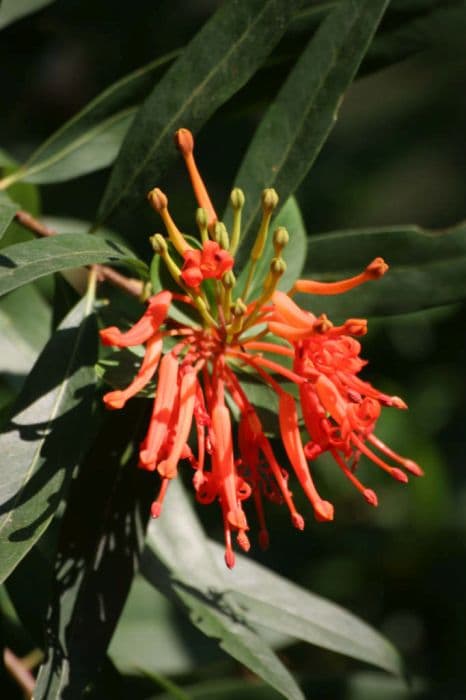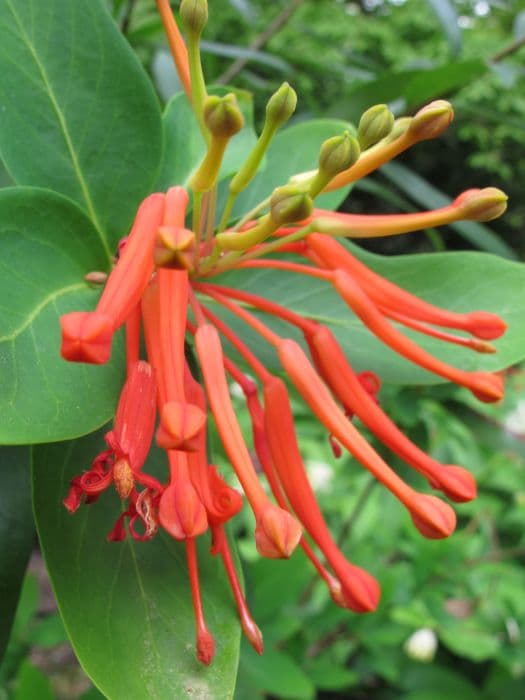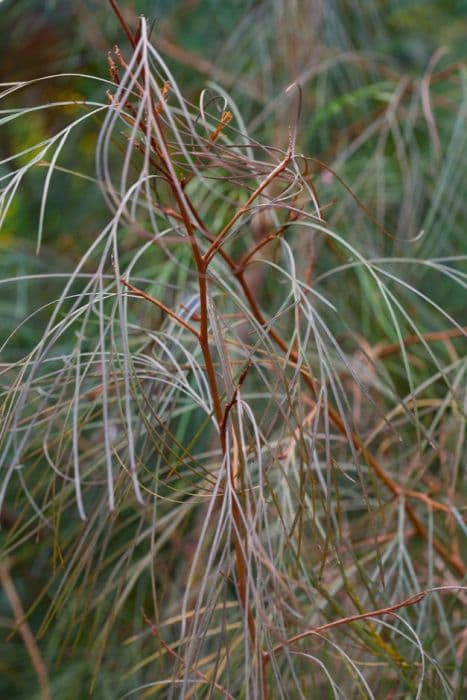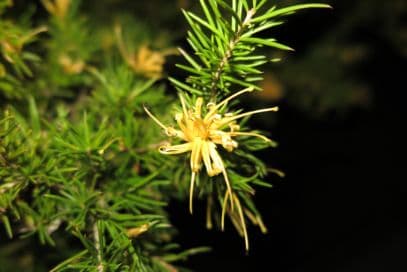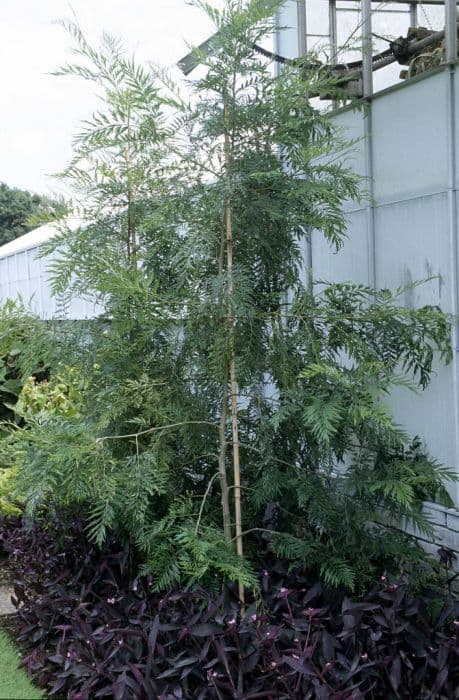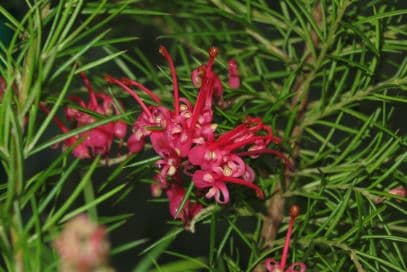Common Conebush Leucadendron salignum 'Fireglow'

ABOUT
Leucadendron 'Fireglow' is a visually stunning plant known for its striking foliage and vibrant coloration. The plant is characterized by its glossy, green leaves which transition into a fiery blend of reds, oranges, and yellows as the seasons change. This colorful display is particularly intense during the cooler months of the year, making it a popular choice for adding warmth to gardens during these times. The leaves themselves are narrow and pointed, resembling slender lance tips that spiral around the stem, creating a lush and textured appearance. Contrasting with the vivid foliage, the flowers of the 'Fireglow' are relatively inconspicuous, with the male and female flowers appearing on separate plants. The male flowers tend to be a yellowish color, while the female flowers, when pollinated, can develop into cone-like structures that add an additional element of interest to the plant's overall look. Interestingly, it is not just the leaves that boast color; the stems and branches of the 'Fireglow' can take on reddish hues, contributing to the plant's fiery theme and making it a very attractive specimen for ornamental purposes. This plant can serve as an excellent focal point in gardens or landscape designs where its colors can provide a beautiful contrast against green foliage or complement other warm-toned plants. Overall, the Leucadendron 'Fireglow' is a vivid and dynamic plant that brings a splash of color to any setting in which it is planted.
About this plant
 Names
NamesFamily
Proteaceae.
Synonyms
Common Sunshine Conebush, Fireglow.
Common names
Leucadendron salignum 'Fireglow'.
 Toxicity
ToxicityTo humans
Commonly known as Fireglow, Leucadendron salignum 'Fireglow' is not widely reported to be toxic to humans. However, like many plants, it is not intended for consumption, and eating any part of the plant may cause gastrointestinal discomfort or other non-specific symptoms. It is always advisable to handle plants with care and avoid ingesting parts of ornamental plants.
To pets
Fireglow is also not widely reported to be toxic to pets. However, as with humans, non-food plants can cause gastrointestinal upset or other discomfort if ingested by pets. It is always best to keep plants out of reach of pets and to consult with a veterinarian if accidental ingestion occurs and your pet exhibits any signs of distress.
 Characteristics
CharacteristicsLife cycle
Perennials
Foliage type
Evergreen
Color of leaves
Green
Height
3-6 feet (0.9-1.8 meters)
Spread
3-6 feet (0.9-1.8 meters)
Plant type
Shrub
Hardiness zones
8-10
Native area
South Africa
Benefits
 General Benefits
General Benefits- Ornamental Appeal: Adds vibrant color and unique texture to gardens with its distinctive foliage and fiery-hued bracts.
- Drought Tolerance: Once established, it requires minimal watering, making it suitable for xeriscaping and dry climate gardens.
- Low Maintenance: Requires little pruning or care, making it an easy plant to grow for gardeners of all skill levels.
- Attracts Wildlife: Provides nectar for birds and insects, including pollinators like bees and butterflies.
- Year-round Interest: Its evergreen nature and seasonal color changes provide visual interest throughout the year.
- Soil Adaptability: Capable of thriving in a variety of soil types, though it prefers well-drained soil.
- Wind Resistance: Sturdy and capable of withstanding windy conditions, which makes it suitable for coastal regions.
 Medical Properties
Medical PropertiesThis plant is not used for medical purposes.
 Air-purifying Qualities
Air-purifying QualitiesThis plant is not specifically known for air purifying qualities.
 Other Uses
Other Uses- Photographic Subjects: The striking colors of the Fireglow can serve as an excellent subject for photography, capturing the vibrant reds for art and stock image purposes.
- Themed Gardens: Fireglow can be used as a feature plant in gardens with a fire or volcano theme due to its fiery red foliage which is especially pronounced in the late winter and spring.
- Drought-Tolerant Landscaping: Due to its ability to withstand dry conditions, Fireglow is a suitable choice for xeriscaping or drought-resistant landscapes.
- Erosion Control: The robust root system of Fireglow makes it useful for stabilizing slopes and controlling soil erosion in windy or sloped areas.
- Privacy Screening: When planted en masse, Fireglow can serve as a privacy screen due to its dense growth habit.
- Hedge Planting: Gardeners can use it to create low to medium-sized hedges for borders or garden separations.
- Culinary Garnish: Though not commonly known for this use, the vibrant leaves can serve as temporary garnish for plating in high-end culinary presentations.
- Seasonal Decoration: The bright foliage of Fireglow can be included in fall floral arrangements or wreaths to complement the autumn palette.
- Living Fences: By strategic planting and training, Fireglow can form a living fence, combining both functionality and aesthetic appeal.
- Tannin Source: The plant's bark and leaves contain tannins, which can potentially be utilized in the tanning industry for leather production.
Interesting Facts
 Feng Shui
Feng ShuiThe Fireglow is not used in Feng Shui practice.
 Zodiac Sign Compitability
Zodiac Sign CompitabilityThe Fireglow is not used in astrology practice.
 Plant Symbolism
Plant Symbolism- Resilience and Strength: The Leucadendron salignum 'Fireglow', commonly known as the Common Sunshine Conebush, is a hardy plant that thrives in tough conditions, symbolizing the ability to withstand adversity.
- Transformation and Renewal: As a plant that regenerates after fire, the Common Sunshine Conebush represents the cycle of renewal and the transformative power of nature.
- Vibrancy and Energy: With its bright, fiery-hued bracts, the Common Sunshine Conebush is often seen as a symbol of vibrance and dynamic energy, bringing life and excitement to its surroundings.
 Water
WaterCommon sage, or Leucadendron 'Fireglow', should be watered deeply but infrequently. It's best to water the plant when the top 2-3 inches of soil feel dry to the touch. This might mean watering about once a week during active growth periods in warmer seasons, and less during cooler seasons. Since Leucadendrons are drought-tolerant, they typically require about 1 gallon of water per plant for each watering session, although this can vary depending on the size of the plant and environmental conditions.
 Light
LightLeucadendron 'Fireglow' thrives best in full sunlight. It should be planted in a spot where it can receive at least six hours of direct sun daily. An area that is south-facing will usually provide the optimal amount of light for this plant to grow strong and vibrant.
 Temperature
TemperatureCommon sage, or Leucadendron 'Fireglow', prefers a mild climate and can tolerate temperatures as low as 20 to 25 degrees Fahrenheit, but it thrives in temperatures between 60 to 75 degrees Fahrenheit. It should be protected from frost and extreme cold, which means in colder climates it's preferable to grow it in pots that can be moved indoors during winter.
 Pruning
PruningLeucadendron 'Fireglow' requires minimal pruning which is generally done to maintain shape and encourage bushier growth. The best time to prune is after the plant has finished blooming in the spring. Remove any dead or damaged branches and cut back up to one-third of the plant to promote new growth. Pruning can be done once a year or every few years as needed.
 Cleaning
CleaningAs needed
 Soil
SoilLeucadendron, commonly known as the Conebush 'Fireglow', requires well-draining, acidic soil with a pH of around 5.5 to 6.5. A soil mix composed of 2 parts peat, 1 part perlite or coarse sand, and 1 part fine bark works well, ensuring good aeration and drainage.
 Repotting
RepottingConebush 'Fireglow' should generally be repotted every 2 to 3 years, preferring not to be disturbed often. Use a suitable well-draining acidic soil mix during repotting.
 Humidity & Misting
Humidity & MistingConebush 'Fireglow' prefers a moderate humidity level, around 40-60%. It is tolerant of drier air, especially once well-established, but should not be in excessively humid conditions.
 Suitable locations
Suitable locationsIndoor
Provide bright light, well-drained soil, water sparingly.
Outdoor
Full sun, well-drained soil, protect from frost.
Hardiness zone
9-11 USDA
 Life cycle
Life cycleThe life of the Leucadendron salignum 'Fireglow', commonly known as the Common Sunshine Conebush, begins with seed germination, which is encouraged by exposure to smoke or fire, simulating the natural fire-prone habitat where it thrives. After germination, the seedling grows gradually, establishing a strong root system and developing its characteristic lance-shaped leaves. As the plant matures, it enters the vegetative stage, where it grows vigorously and forms a woody shrub, often reaching up to 1-1.5 meters in height. During the flowering stage, typically from late winter to spring, the Common Sunshine Conebush produces vivid red inflorescences, which are actually colored bracts surrounding the true flowers, making it highly attractive. After pollination, typically by birds or wind, it develops seeds, which are held in cone-like structures that can persist on the plant for years until they are released by environmental triggers such as fire. The plant has a lifespan that can exceed 20 years in the right conditions, after which it completes its life cycle, leaving behind seeds to regenerate and continue the species.
 Propogation
PropogationPropogation time
Spring to Summer
The most popular method of propagation for the Leucadendron salignum 'Fireglow', commonly known as Fireglow, is through semi-hardwood cuttings. The best time to take these cuttings is during the late summer or early fall. Cuttings should be taken from the current year's growth, approximately 4 to 6 inches (10 to 15 centimeters) in length. The lower leaves are stripped, and the base of the cutting is dipped in a rooting hormone to encourage root development. The prepared cuttings are then planted in a well-draining, sterile medium, such as a mix of perlite and peat, and kept moist until roots have established. It's important to provide a humid environment, which can be achieved by covering the cuttings with a plastic dome or placing them in a propagation misting system.
